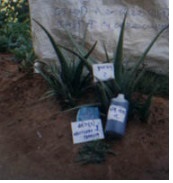Name : Mr. Rajnikant Bhai Patel
District & State : -1, Gujarat
Category : Utility
Award : State
Award Function : 1st National Grassroots Innovation Awards
Award Year : 2001
Innovation Description
 There are few village level workers who generate so much respect among their clients as Rajnibhai does. He has seven herbal formulations for controlling different pests to his credit in 10 years. He has been a Gram Sevak since December 1983. He has obtained diploma in Agriculture in 1982 and has undergone numerous departmental trainings. He was promoting the use of fertilizer and pesticide till 1990. The turning point in his thinking came, when he joined the ‘Swadhayay Parivar’ a religious sect that believes in promoting organic farming. Once the head of the sect, Pandurang Shastri came to a village in Sabarkantha and asked his followers to plant crops without using fertilisers or pesticides.This forced Rajnikantbhai to think about alternatives to pesticides and fertilisers. Ever keen to learn and promote new ways of organic agriculture he has managed to earn the respect of his superiors in departments and peers in NGOs also.
There are few village level workers who generate so much respect among their clients as Rajnibhai does. He has seven herbal formulations for controlling different pests to his credit in 10 years. He has been a Gram Sevak since December 1983. He has obtained diploma in Agriculture in 1982 and has undergone numerous departmental trainings. He was promoting the use of fertilizer and pesticide till 1990. The turning point in his thinking came, when he joined the ‘Swadhayay Parivar’ a religious sect that believes in promoting organic farming. Once the head of the sect, Pandurang Shastri came to a village in Sabarkantha and asked his followers to plant crops without using fertilisers or pesticides.This forced Rajnikantbhai to think about alternatives to pesticides and fertilisers. Ever keen to learn and promote new ways of organic agriculture he has managed to earn the respect of his superiors in departments and peers in NGOs also.
Control of sucking pests 3 kg of black veldi (croton sp.) leaves are to be taken and boiled for three hours in 20 lits of water. After this, when the volume would reduce to about 5 lt. it should be sieved properly and sprayed on cotton, castor and other green leafy vegetables in order to control sucking pests. The spray should be repeated after 10 days.
Control of Prodenia and Heliothis larvae:
4 kg Aloe vera sp. (kuwar-patha) + Neem oil 500 ml + tobacco snuff decoction 500ml should be added in 20 lits. Of water and boiled for 3 to 4 hours. After that, when the volume of water would decrease to about 5 lits. It should be allowed to become cold and sieved properly. This should be sprayed on cotton, Lady’s finger (Bhindi) etc. For effective control of Prodenia and Heliothis larvae. The pesticide is named as NEEKUNCHI [neem +Aloe vera + chi (tobacco snuff decoction)]
Dose: 100 to 150 ml of extract (mixture) should be diluted in 15 lits of water and sprayed. The spray should be repeated after 10 days.
Control of sucking pests with the help of predators:
Calotropis sps. Are to be grown around the field of crop plants in which the Ladybird beetle would take shelter.
The Calotropis leaves should be then spread in the field so that the Ladybird beetles could easily feed on the sucking pests, as it is a predator of sucking pests. Thus, the sucking pests could be controlled.
Farming of mustard without ploughing the field:
Due to lack of proper irrigation facilities, mustard was intercropped with maize and irrigation was provided at an interval of 7 days for 2 hours each in one plot. In another unploughed plot, mustard was sowed where irrigation was provided at an interval of 18 days. It was found that the second plot gave better yield of mustard and also saved cost and time.
Crop protection using herbal formulations:
(1) The latex of Euphorbia nerifolia can be used to control wilt, rotting & termites in various crop plants like pomegranate, castor, wheat, legumes etc.
(2) The Juice of leaves of Hautana camara, can be used to control white flies. Due to control of these flies wilt in cotton can be controlled, since white flies act as a vector of wilt. In this process only the apical leaves are utilized.
(3) The extract of Jatropha can be used for the control of sucking pests.
(4) Salvadora loeoides can be used for the control of powdery mildew.
(5) Nicotiana tobacum powder is used to control Prodenia.
(6) Farming of organic wheat rice & potato organic control of spodoptera in organic potato farming.
http://nif.org.in/innovation/Control_of_sucking_pest_Control_of_Prodenia_and_Heliothis_etc/160
